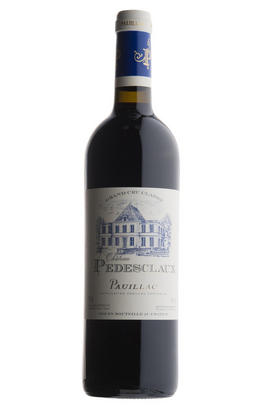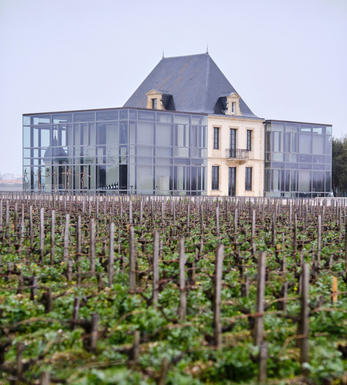
2010 Château Pédesclaux, Pauillac, Bordeaux

Critics reviews
Neal Martin - 01/03/2017
Tasted 5 Apr: Fine and almost burgundian in its sensual appeal. Sweet and juicy. Unusual and interesting. (Score: 15.5 15-20)
Jancis Robinson MW- jancis robinson.com, Apr 2011
James Molesworth – The Wine Spectator – Apr 2011
This under-achieving estate, which is under the same management as Chateau Lilian Ladouys, seems to have made a huge step forward with this wine.
89 Robert Parker- Wine Advocate- Feb 2013
Perhaps the finest Pedesclaux I have ever tasted, this property appears to be coming back. Although this is hardly an inspirational wine, it is good, possibly very good with a dark ruby/purple color, medium-body as well as notes of cedarwood, black currants and spice box.
85-87 Robert Parker- Wine Advocate- May 2011
About this WINE

Chateau Pedesclaux
One of Pauillac’s less well-known estates, Ch. Pédesclaux is well situated in front of Mouton Rothschild and Pontet-Canet. The property’s history dates back to the early 19th century when Urbain Pédesclaux – a renowned trader on the Bordeaux marketplace – acquired some vineyards put up for sale following the Revolution and established the estate in 1810. Symbolising the bourgeoisie’s arrival in the Médoc (previously under aristocratic rule), Urbain Pierre Pédesclaux set about building the estate’s reputation. When the wines of the region were classified in 1855, Ch. Pédesclaux was granted the title of Fifth Growth.
The estate was acquired by Françoise and Jacky Lorenzetti in 2009. Over the next few years they purchased new parcels, almost doubling the property’s footprint from 26 to 50 hectares. The vineyards underwent significant work with soil studies and replanting, and in 2014, Ch. Pédesclaux opened a new chapter, its vineyards fully restructured and an impressive new gravity-fed winery and cellaring facilities.

Pauillac
Pauillac is the aristocrat of the Médoc boasting boasting 75 percent of the region’s First Growths and with Grand Cru Classés representing 84 percent of Pauillac's production.
For a small town, surrounded by so many familiar and regal names, Pauillac imparts a slightly seedy impression. There are no grand hotels or restaurants – with the honourable exception of the establishments owned by Jean-Michel Cazes – rather a small port and yacht harbour, and a dominant petrochemical plant.
Yet outside the town, , there is arguably the greatest concentration of fabulous vineyards throughout all Bordeaux, including three of the five First Growths. Bordering St Estèphe to the north and St Julien to the south, Pauillac has fine, deep gravel soils with important iron and marl deposits, and a subtle, softly-rolling landscape, cut by a series of small streams running into the Gironde. The vineyards are located on two gravel-rich plateaux, one to the northwest of the town of Pauillac and the other to the south, with the vines reaching a greater depth than anywhere else in the Médoc.
Pauillac's first growths each have their own unique characteristics; Lafite Rothschild, tucked in the northern part of Pauillac on the St Estèphe border, produces Pauillac's most aromatically complex and subtly-flavoured wine. Mouton Rothschild's vineyards lie on a well-drained gravel ridge and - with its high percentage of Cabernet Sauvignon - can produce (in its best years) Pauillac's most decadently rich, fleshy and exotic wine.
Latour, arguably Bordeaux's most consistent First Growth, is located in southern Pauillac next to St Julien. Its soil is gravel-rich with superb drainage, and Latour's vines penetrate as far as five metres into the soil. It produces perhaps the most long-lived wines of the Médoc.
Recommended Châteaux
Ch. Lafite-Rothschild, Ch. Latour, Ch. Mouton-Rothschild, Ch. Pichon-Longueville Baron, Ch. Pichon Longueville Comtesse de Lalande, Ch. Lynch-Bages, Ch. Grand-Puy-Lacoste, Ch, Pontet-Canet, Les Forts de Latour, Ch. Haut-Batailley, Ch. Batailley, Ch. Haut-Bages Libéral.

Cabernet Sauvignon Blend
Cabernet Sauvignon lends itself particularly well in blends with Merlot. This is actually the archetypal Bordeaux blend, though in different proportions in the sub-regions and sometimes topped up with Cabernet Franc, Malbec, and Petit Verdot.
In the Médoc and Graves the percentage of Cabernet Sauvignon in the blend can range from 95% (Mouton-Rothschild) to as low as 40%. It is particularly suited to the dry, warm, free- draining, gravel-rich soils and is responsible for the redolent cassis characteristics as well as the depth of colour, tannic structure and pronounced acidity of Médoc wines. However 100% Cabernet Sauvignon wines can be slightly hollow-tasting in the middle palate and Merlot with its generous, fleshy fruit flavours acts as a perfect foil by filling in this cavity.
In St-Emilion and Pomerol, the blends are Merlot dominated as Cabernet Sauvignon can struggle to ripen there - when it is included, it adds structure and body to the wine. Sassicaia is the most famous Bordeaux blend in Italy and has spawned many imitations, whereby the blend is now firmly established in the New World and particularly in California and Australia.


Buying options
Add to wishlist
Description
Wow! A profound, precise Pauillac at a price to please even the most price conscious (I hope!). Raspberries and strawberries are dominant on nose and palate, with a very natural weight and comely seductive charm that just makes you want to quaff it. This really is a terrific and something new to boot.
Simon Staples, Asia Wine Director
wine at a glance
Delivery and quality guarantee